Nepal
Nepal is a small country located in South Asia. It is a multi-cultural country and the 2011 census indicates that it has a total of 102 ethnic groups and 92 languages. The official language of the country is Nepalese. It extends about 850 kilometers from east to west and about 200 kilometers from north to south, and is 147,181 square kilometers in area (CBS, 2011).
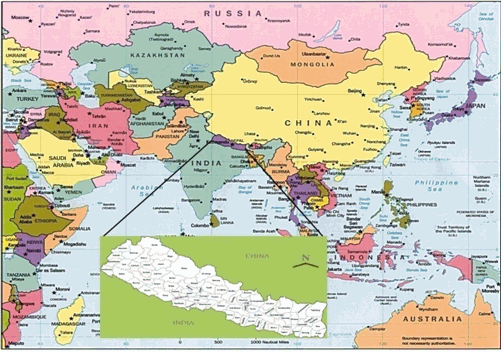
Figure 1: Nepal in the Map of Asia
Source : (Upreti,2011)
Known for its majestic Himalayas, which in Sanskrit means the abode of snow, the country is situated mainly along the southern slopes of the Himalayas, the highest chain of mountains in the world. One-third of the 2,400 kilometer Himalayan range lies in Nepal. Nepal is land locked country. The country is surrounded by India on three sides and by the China's autonomous Tibetan land to the north. It is separated from Bangladesh by 15-kilometer wide strip of Indian West Bengal, and from Bhutan by 88-kilometer wide Sikkim. The nearest seaport, Kolkata, India, is at a distance of 400 kilometers. Nepal is highly dependent on India for transit facilities and access to the sea (nearest sea port is in the Bay of Bengal) and is even dependent on Indian sea port for most of the goods coming from China.
According to the National Population Census 2011, the total population of the country is 26,620,809 which shows an increase of population at the rate of 1.4% per annum. The last census i.e. National Population Census 2001, reported that population was 23,151,423 and growth rate was 2.25% (Government of Nepal, Priliminary Result of National Population Census, 2011).
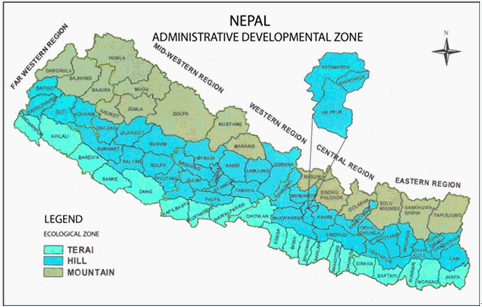
Figure 2: Map of Nepal
Source : (Upreti,2011)
Pre-school in Nepal
Until the 1950s, Nepal remained virtually isolated from the outside world. In Nepal, formal school education has been in the process of development only since 1950. In the early 1950s the total literacy rate was about 2%. It was only after 1951 that primary education started to develop in Nepal and particularly early childhood education was the most neglected aspect in the whole education system of Nepal.
Today the Nepalese education system is rapidly expanding and striving to meet the needs of all children. Early childhood development (ECD) has for a long time been given less importance than it deserves. Care of young children has not been given enough attention, especially within the family and home.
Though preschools were started in 1950 with the establishment of a Montessori school in Kathmandu and BalMandirs (local orphanages) in some districts, its importance has been realized only lately.
Table 1: ECD centers in Nepal from 2006- 2008
| Nepal ECD centers | 2006 | 2007 | 2008 |
|---|---|---|---|
| Community based ECD | 229 | 6,332 | 6,332 |
| Government School ECD | 5,835 | 10,191 | 13,691 |
| Private School ECD | 3,313 | 3,413 | 3,636 |
| Total | 9,377 | 19,936 | 23,659 |
Table 1 showing the increasing number of ECD centers in Nepal.
Source: Department of Education, Education Ministry & Government of Nepal (2008). Kathmandu.
The latest statistics indicates that there are over 24,000 school based and community based ECD centers in the country (Flash report 2007). The Government of Nepal started taking interest in ECD programs at the implementation of the country's Seventh Plan (1987-1992). In the Seventh Plan, the government realized the need for appropriate services for children from the time of conception. However, the government has not developed specific or concrete plans and policies other than encouraging families and communities to take initiative in delivering child care services. In the Eighth Plan (1992-1997) the government reiterated the statements made in the Seventh Plan. In the Ninth Plan (1997-2002) the government developed some specific plans and policies for the expansion of ECD programs in the country. The Ninth Plan had aimed to establish 10,000 pre-primary schools under the Basic and Primary Education Project (BPEP) but the implementation number had been reduced to 5,700. The achieved number is 2,915. The Tenth Plan (2003-2008) has targeted to establish 13,000 pre-primary schools. According to Flash Report 2010/2011 there are 31,089 ECD/Pre-Primary Classes (PPCs) in the country, 26,773 (86.1%) ECDs are running as community-based ECD centers and community school based ECD/PPCs. Thus rest 4,316 (13.9%) of the ECD/PPCs are run by private schools.
Types of ECD Centers and Pre-primary Classes in Nepal
- Community based and school based which are initiated by government, NGOs/INGOs and private.
- Pre-primary classes attached to primary schools (in private and government schools)
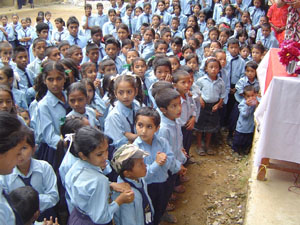
Children in the government school
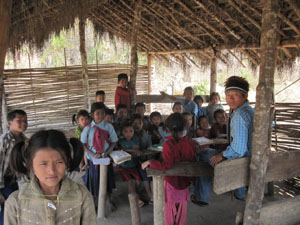
Children in the government school in a rural area
ECD Curriculum in Nepal
Department of Education, Early Childhood Development Section has prepared a curriculum handbook for all private schools, community schools and early childhood development centers which are conducting early childhood development program for the children of age three to four years.
This curriculum handbook is divided into three parts:
a. introduction, goal, ECD environment
b. curriculum; fundamental learning area and subject-wise area
c. theme-wise activities (Department of Education 2006)
Table 2: Daily Age-wise activity distribution for childhood development in ECD centers
| Serial Number |
Area | 3years | 4years |
|---|---|---|---|
1 |
Acquisition and establishment of health habit, moral norms and values and life skills development |
30mins. | 40mins. |
2 |
Free games | 60mins. | 45mins. |
3 |
Linguistic expressions | 45mins | 60mins. |
4 |
Planned social activities | 30mins. | 45mins. |
5 |
Gross motor development | 45mins. | 30mins. |
6 |
Planned learning activities | 30mins. | 60mins. |
| Total time | 240mins. (4hrs) |
270mins. (4½hrs) |
*In this table 2, time for the activities is less for 3years old children compared to 4 years old children.
Table 3: Daily time schedule recommended for an ECD center
| Serial Number |
Activities | Time |
|---|---|---|
1 |
Out-door games | 15mins. |
2 |
Physical games and socialization | 15mins. |
3 |
Group work | 30mins. |
4 |
Planned activities | 15-30mins. |
5 |
Personal games | 15mins. |
6 |
Group planned games/activities | 20mins. |
7 |
Health moral messages/rest | 10mins. |
8 |
Lunch and toilet | - |
9 |
Music and role playing | 30mins. |
10 |
Rest | 10mins. |
11 |
Planned activities | 15-30mins. |
12 |
Personal free activities | 25mins. |
13 |
Group planned activities | 10mins. |
14 |
Musical expressions | 10mins. |
15 |
Classroom management | 15mins. |
16 |
Personal preparation to return home | 10mins. |
According to age, children have to stay in the center or Nursery, LKG (Lower Kindergarten) class for a minimum of 4 to 5 hours a day and centers or classes must be conducted for 32 weeks in a year (6 days a week- Sunday to Friday, 10 am-2/3 pm).
The goal of ECD curriculum is to make children capable in all areas of development.
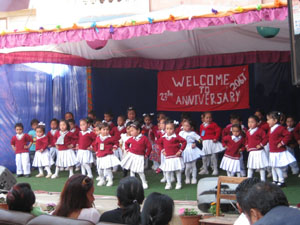
Children in a private school
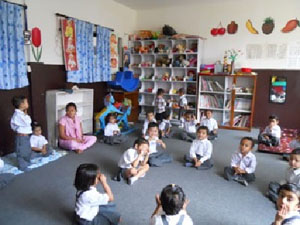
Pre-clasroom in a private school
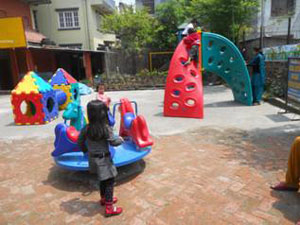
Pre-school playing area in a private school
Patterns of Operation
Both private and government ECD centers are generally open from Sunday to Friday. Most ECD centers and pre-primary schools are open from 10 am to 3 pm. While some private ECD centers and Nursery schools are more flexible. Beside national holidays there are winter vacation of 45 days and summer vacation of 15 days in the government schools of Kathmandu valley. In private schools this winter and summer vacation also depend on their own calendar.
School Based Early Childhood Development (SBECD) and Community Based Early Childhood Development (CBECD) centers are being operated in three modes: Government initiatives, INGO/NGO Partnership and government and INGO partnership.
In Nepal, ECD programs are increasing in number but quality varies according to area. In urban area there are different qualities of ECD program - expensive, well equipped and low qualities with few facilities. In rural and remote areas, ECD centers do not have trained teachers and enough learning materials for children.
A small research conducted by the author 9 government and 9 private schools were selected and observed school and classroom environment.
The findings were as follows:
1.Schools were located in wide variety of geographical locations (Mountain, plain, rural, urban) in Nepal.
2.Problems faced by the ECD programs in different areas are :
- Inadequate infrastructure.
- Unqualified and poorly skilled teachers and caregivers.
- In the pre-primary classes learning materials and toys are scarce and quality of stationary is extremely poor.
- In government schools the school buildings are large but poorly organized.
Chart 1.
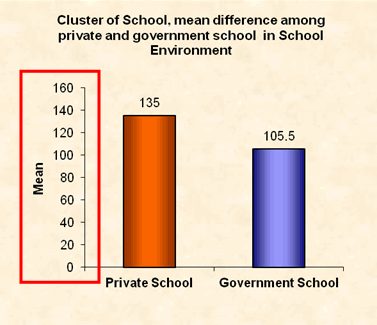
The graph shows that the school environment is poor and not suitable for caring children in Government schools compared to private schools. The total score of school environment was 248 and obtained average score was 135.0 in private school and 105.5 in government school.
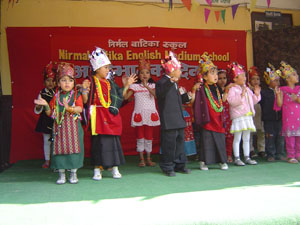
Children in a private school
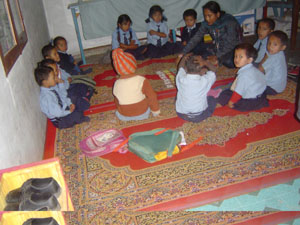
Pre-classroom in the government school
References
- Nepal, G. (2011). Statical year book of Nepal. Kathmandu: Government of Nepal ,Ministry of education.
- Acharya, U. D. (2002). primary education in Nepal. Kathmandu: EKkata Books Distributers.
- Shrestha, K., Bajracharya, H. R., Aryal, P. N., Thapa, R., & Bajracharya, U. (2008). Early Childhood Policy Review in Nepal. Kathmandu,Balkhu: CERID.
- UNICEF. (2007, december). Retrieved 5 19, 1011, from http://www.unicef.org/earlychildhood/index.html
- Nepal, Government .(2007). Flash I Report 2007/08 Sanothimi ,Bhaktapur: Ministry of Education.
- Upreti, Nirmala. Development During Early Childhood: Pre-primary Education in Nepal. Delhi ,India: Nirmala Upreti, 2011.
- Department of Education, Ministry of Education,Government of Nepal. ECD Curriculum Handbook. - 2006. 15 08 2011 <http:www.doe.gov.np>.














